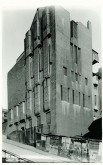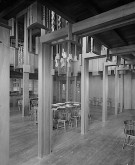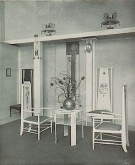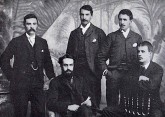The browser will either open the file, download it, or display a dialog.
Mackintosh Architecture: Context, Making and Meaning
http://www.mackintosh-architecture.gla.ac.uk/
Online catalogue raisonné of the architecture of Charles Rennie Mackintosh
Digitally published and maintained by the University of Glasgow
(full launch July 18, 2014)
Principal Investigator: Pamela Robertson
Chief Researcher: Joseph Sharples
Post-Doctoral Researcher: Nicky Imrie
The tragic fire of May 23, 2014 that badly damaged The Glasgow School of Art and destroyed the famous Mackintosh library (figs. 1, 2) serves as a sad reminder of the potential impermanence of both beloved architectural spaces as well as the documents housed within. As Mackintosh scholars convene in Glasgow this fall for the Hunterian’s symposium on the architecture of Charles Rennie Mackintosh (1868–1928), the value of the University of Glasgow’s recently launched online architectural catalogue raisonné will doubtlessly be at the forefront of discussions concerning the restoration of Mackintosh’s masterpiece. With the rebuilding of the library, the scholarly work of Pamela Robertson, Joseph Sharples, and Nicky Imrie will prove an invaluable resource, providing digital access not only to 75 extant architectural drawings and additional period photographs of the School of Art, but also a careful reconstruction of the records of the architectural firm of Honeyman & Keppie / Honeyman, Keppie & Mackintosh during the original period of construction.[1] Based upon analysis of the firm’s job book, visit book, and cash book (for which zoomable scans are fully reproduced in the catalogue), this timely research provides valuable insight into the construction process and the relationships developed with the many contractors who contributed.
While Mackintosh has long been celebrated as a major figure bridging the span from the Arts and Crafts revival of the nineteenth century to the comparatively unsentimental aesthetics of art deco and the geometric abstraction of the early twentieth century, the lack of an architectural catalogue raisonné has been a major gap in what has otherwise been a fairly well-chronicled œuvre. The University of Glasgow’s newly launched online catalogue Mackintosh Architecture: Context, Making and Meaning steps forward not only to meet this research gap, but to make the information available freely to international scholars and the public alike through an excellently designed, easily useable digital interface. As a substantial work of scholarship including catalog entries, scanned archival material, and lengthy analytical essays, this new architectural catalogue serves as a valuable update to the foundational work of Thomas Howarth in Charles Rennie Mackintosh and the Modern Movement and as an outstanding companion to Roger Billcliffe’s Charles Rennie Mackintosh: The Complete Furniture Drawings and Interior Designs, to which readers are referred for detailed information on Mackintosh’s interior design work.[2]
For those whose anticipation was whetted by the teaser website previewed in the Spring 2014 issue of Nineteenth-Century Art Worldwide, the fully launched catalogue does not disappoint. The site underwent extensive pre-launch testing, incorporating feedback from an array of representative anticipated users, and the result is a sensibly functional and intuitively navigable design. The site is clearly organized, with the bulk of material accessible through the link to the catalogue. While supplementary elements such as the glossary of common-to-rare architectural terms and the collection of 300 biographies can be independently consulted, the authors have also helpfully hyperlinked wherever logical so that connections and questions can be easily and quickly explored.
The catalogue is the product of four years of research and development by a team of experts at the University of Glasgow’s Hunterian Museum, supported in part by a major grant from the Arts and Humanities Research Council. With virtually unlimited publication space, the catalogue has the luxury of including not only architectural projects for which Mackintosh’s direct involvement is documented or firmly attributed on the basis of style, but also a larger body of projects undertaken by the Glasgow firm Honeyman & Keppie / Honeyman, Keppie & Mackintosh from the period of 1889–1913, during which Mackintosh was associated with the firm. The resulting catalogue is exhaustive in its scope, providing detailed entries for 126 projects for which architectural and design work is firmly attributed to Mackintosh as well as an additional 230 entries documenting every architectural project undertaken by the firm while Mackintosh was present as an associate or partner. Although the entries in this latter category are generally more cursory, they are as a whole a considerable contribution to the scholarly understanding of the professional context in which Mackintosh worked and are included under the rationale that architectural firms rely upon a collaborative environment, and work credited to the firm’s partners was often undertaken by associates who remained unnamed, a practice that much chagrined the young and ambitious Mackintosh.[3] The catalogue further demonstrates that attributing Mackintosh’s involvement on the basis of style is also a limited approach, as circumstances necessitated that he conform to the wishes of clients in courting much-needed commissions as a partner, as is evidenced by his work on projects such as the Tudor-style country home Auchinibert, built for the assistant manager of Nobel’s Explosives.
Illustrated by approximately 3200 images, the catalogue documents architectural structures as well as model interiors, such as those exhibited by the Glasgow Four in 1900 at the Eighth Exhibition of the Vienna Secession as well as Mackintosh interiors exhibited in Turin (1902; fig. 3), Moscow (1902), Dresden (1903), and Berlin (1905). The catalogue additionally incorporates more than 1200 high-quality reproductions of architectural drawings as well as conceptions for visionary unrealized projects such as Mackintosh’s designs for “A House for an Art Lover,” submitted to a competition organized by Alexander Koch, publisher of Innendekoration (Darmstadt).[4]
The 358 catalog entries generally include a brief introduction detailing the circumstances of commission, manner for establishing attribution, location, current status, and current use (if extant) along with a detailed, fully annotated chronology of design, construction, and major events in a structure’s history, with hyperlinks to terms in the glossary and to figures for whom further biographic essays are available. Each catalog entry additionally includes a section for the reproduction of architectural drawings (if available) and a separate section containing a selection of supplemental images, typically including period photographs from UK publications as well as international sources such as Dekorative Kunst, Kunst und Dekoration, and Ver Sacrum, updated digital photographs of extant structures, floor plans, axonometric renderings, and short un-narrated film tours for a number of the best known Mackintosh structures. Both the compilation of the period photographs as well as the substantial descriptive essays that accompany many catalogue entries draw upon in-depth research amongst archival documents and period publications as well as up-to-date scholarly research and field documentation. When included, the descriptive essays are typically extensive, illustrated, and fully annotated, constituting a major source of scholarship for individual projects. While catalogue entry image collections often include photographic shots of interior spaces designed by Mackintosh, the approach favors documenting the interiors as designed spaces within architectural structures rather than providing a comprehensive visual catalogue of interior design details and individual furnishings and fittings. This is in keeping with the catalog’s mission to focus primarily on surveying Mackintosh’s architectural work rather than duplicating the work that has been previously published pertaining to Mackintosh’s activities as a designer. The catalog entries instead chart major new research territory in mapping out relationships to clients and contractors. The catalogue additionally includes zoomable digitized reproductions of the record books from the office of John Honeyman & Keppie / Honeyman, Keppie & Mackintosh for the period of Mackintosh’s involvement with the firm (1889–1913). This digitized archival material includes the office’s job book, visitor book, and cash book, which records income and expenditures, now universally available for researchers to peruse. In some cases the archival section of a catalog entry may include additional material such as competition submission paperwork or correspondence. Finally, while the catalogue contains a comprehensive bibliography, each catalog entry is accompanied by its own specialized bibliography listing period and scholarly sources as well as unpublished resources for those pursuing focused research.
The catalogue is organized to allow users to browse, search by keyword, sort results by date, title, or cost, or to filter for building type (such as residential, educational, tea rooms, etc.). In the browse section, researchers are also presented with the option to filter results based upon the level of involvement Mackintosh had with projects. The website distinguishes amongst four levels, ranked in descending order from direct involvement to mere proximity to Mackintosh via the architectural firm with which he worked. While exploring the catalogue was for the most part quite intuitive in the experience of this reviewer, the full extent of the catalogue is not immediately apparent to researchers accustomed to search results listing the full range of material available. If, for example, a search for the Glasgow School of Art is performed, only one representative image for the catalogue entry will be returned. Researchers must select the catalogue entry and then navigate among the subcategories within it to access the full extent of archival, photographic, and analytic material available. Adding a prominent note advising researchers of this navigation design would likely increase usability.
In addition to the more than 350 individual entries, many with accompanying descriptive essays, the catalogue contains a substantial biography of Mackintosh, focused in particular upon his Glasgow period, along with an informative series of essays providing insight gleaned from archival research into the operations of Honeyman & Keppie / Honeyman, Keppie & Mackintosh and the network of clients and contractors who made the physical realization of Mackintosh’s architectural designs possible. These essays provide practical details of the professional circumstances within which Mackintosh worked, the demands of nurturing relationships with clients, the pressures of overseeing contractors at building sites and navigating increasingly stringent building regulations overseen by the Dean of Court Guilds, all while meeting with negligible critical support in Glasgow and seeking out recognition from continental Europeans more sympathetic to design trends in Art Nouveau and Jugendstil. Although with the exception of the excellent essay “Mackintosh and Materials,” these essays are not rigorously interpretive, they are effective in presenting clear analysis of the documentary evidence researched in support of the catalogue’s goal of providing a detailed, holistic understanding of the context within which Mackintosh labored (fig. 4).
The advantages of online publication of a catalog raisonné include not only the ability to evade concerns regarding length, amount of supplementary material, and number and size of illustrations, but also the ability to incorporate tools that are greatly enhanced by interactivity. Among these inclusions in the Mackintosh catalog are an interactive timeline, enabling researchers to easily assess the relation of various projects to each other and to key events in Mackintosh’s life, as well as an interactive map, identifying the locations of the projects documented by the catalog. Researchers can zoom out for a comprehensive view of all locations throughout the United Kingdom or zoom in to city or street level to locate building projects within a specific region. Clicking on a pin on the map pulls up a representative image of the individual building site along with corresponding catalog number and title, and current status as extant or demolished. For easy cross-reference, clicking on the representative image transfers the researcher from the map to the specific catalog entry. For researchers seeking the location of a specific structure, all entries are listed alphabetically alongside the map, and clicking on individual titles highlights the corresponding location on the map.
While the Mackintosh online catalog raisonné is part of a forward-looking move to online publishing and archival digitization, web-based publishing does implicate several significant questions for the art historical field. One is a reassessment of the nature of authorship for collaborative projects published in a format that can be easily altered and updated in the future. Similar to the organization of the architectural firm with which Mackintosh worked, research and writing on this project was undertaken collaboratively, and responsibility for individual sections is not credited to a specific author. The catalogue contains no bylines accompanying the Mackintosh biographical essay, any of the substantial thematic analytic essays, or the descriptive and biographical entries included in the catalog entries, and it will be the ongoing responsibility of the holder of the Mackintosh curatorship at the Hunterian to keep the site current. Although this is consistent with standard curatorial practice for posting wall labels and publishing short museum website entries without crediting a specific author, the far more specialized scholarship and the substantial nature of the essays included in the Mackintosh catalog raisonné raise the question of whether providing a record of authorship of component parts would be of value to maintaining clear research integrity responsibility as well as to enabling individual professionals to receive academic credit for their work and to establish and/or maintain their visibility as experts within the field. While in this case the University of Glasgow and the Hunterian Museum lend their institutional academic credibility to the scholarship as a substitute for the practice of consistently crediting specific authors for component essays, the self-published nature of the project raises additional questions concerning the peer-review and editorial mechanisms traditionally in place in academic press publishing to ensure the maintenance of academic standards and research reliability. The Mackintosh online catalogue raisonné is happily a model of judicious self-monitoring in this regard. Thoughtfully anticipating both the concerns of academic colleagues as well as demonstrating sincere appreciation for the legitimate need for editorial review, the researchers solicited an editorial board of respected experts, including Roger Billcliffe, Simon Green, Ranald MacInnes, and David Stark. As online art historical publications of significant scholarly weight continue to appear, however, these will be ongoing academic concerns for art historians to consider. The University of Glasgow’s online catalogue raisonné with research by Pamela Robertson, Joseph Sharples, and Nicky Imrie constitutes not only a significant contribution to Mackintosh scholarship, but also a model of thoughtful development of this exciting publishing format.
Sarah Sik, Ph.D.
Assistant Professor of Art History
Art Department
The University of South Dakota
Sarah.Sik[at]usd.edu
[1] In 1901, Mackintosh became a partner of the firm.
[2] Thomas Howarth, Charles Rennie Mackintosh and the Modern Movement (London: Routledge & Kegan Paul, 1952); Roger Billcliffe, Charles Rennie Mackintosh: The Complete Furniture Drawings and Interior Designs (New York: Taplinger, 1979).
[3] In an 1898 letter to friend and supporter Hermann Muthesius, Mackintosh lamented of his work on the Glasgow Herald Building: “[A]lthough the building in Mitchell Street here was designed by me the Architects are or were Messrs Honeyman & Keppie – who employ me as assistant. So if you reproduce any photographs of the building you must give the architects' name – not mine. You will see that this is very unfortunate for me, but I hope when brighter days come I shall be able to work for myself entirely and claim my work as mine.” A scan of the letter is reproduced in the catalogue.
[4] Although the house was never built during Mackintosh’s lifetime, a structure based upon the designs has since been erected in Glasgow’s Bellahouston Park (1989–1996).






